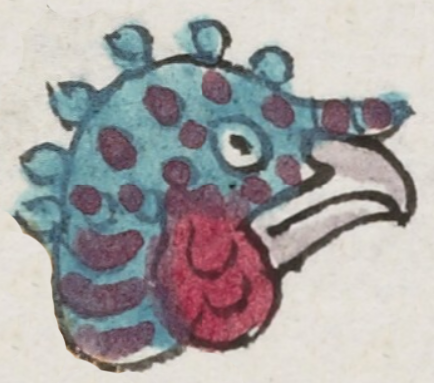totolin (Mdz21v)
This element has been carved from the compound sign for the place name, Totoltzinco. It consists of the head of a turkey, in profile, looking to our right. It is primarily turquoise, with red dots on the head and face and turquoise balls along the top of the head. An extra, fleshy component, bright red, is the snood or wattle. The beak is closed, and it is gray or white. The eye, which is open, is similarly gray or white, with a black pupil.
Stephanie Wood
In the plural, totolin could be male and female, but sometimes the totolin was a female, a hen. Sometimes, for clarity, they were called cihuatotolin, female hens. A turkey could also be called a huexolotl (guajolote in Spanish), but this was more often a male. Turkeys were provided to authorities as a form of taxation in kind (tributes). They were also bought and sold in the marketplace. In our dictionary, one will see that a single totolin hen might cost one or two reales (eighths of pesos), or even up to a peso each. Sometimes warriors who had taken captives anointed themselves with white down feathers of the totolin.
Stephanie Wood
c. 1541, but by 1553 at the latest
Stephanie Wood
huehxolotl, vesulotl, uexolotl, turkeys, hens, turkey cocks, gallipavo, aves de corral, birds, guajolotes, fowl

totol(in), domestic fowl, turkey hen, https://nahuatl.wired-humanities.org/content/totolin
Codex Mendoza, folio 21 verso, https://digital.bodleian.ox.ac.uk/objects/2fea788e-2aa2-4f08-b6d9-648c00..., image 53 of 188.
The Bodleian Libraries, University of Oxford, hold the original manuscript, the MS. Arch. Selden. A. 1. This image is published here under the UK Creative Commons, “Attribution-NonCommercial-ShareAlike 3.0 License” (CC-BY-NC-SA 3.0).

